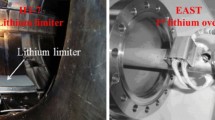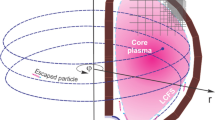Abstract
This study proposes a method to reduce the beamline pollution caused by lithium gas generated when a lithium film is formed while driving a heavy ion accelerator. To this end, the liquefaction and solidification of lithium vapor are utilized, and a skimmer is installed on the beamline to reduce pollution through contact with lithium vapor. Particularly, three curved skimmers were installed in consideration of the length of the beamline to increase the contact area. Analysis results revealed that the lithium film forms lithium gas at 0.5 g/s. When the gas flow generated is converted into a vacuum pump, the vacuum degree of the beam line is 3.88 × 10–7 mbar, which is 1/74 of the vacuum degree of the charge stripper, and approximately 30% lower than that of a straight-type skimmer. Additionally, the flow velocity of lithium particle is 3 × 10–11 m/s, and it takes 1260 years to reach the beamline; accordingly, the results suggest that the use of a curved skimmer will enable the optimal operation of the beamline without any lithium contamination.










Similar content being viewed by others
References
S. Anghaie, A. Ferrari, Rare isotope science project., In Proceedings of the 30th International Electric Propulsion Conference (Florence, Italy, September 17–20).
Rare Isotope Science Project (2012) Baseline design summary.
J. Song, Study of the interaction of charged ions with matter-development of charge stripper and IF production target at RISP [Doctoral dissertation]. Seoul National University (2016).
F. Marti, P. Guetschow, Y. Momozaki, J. A. Nolen, and C. B. Reed, Development of a liquid lithium charge stripper for FRIB. Proceedings of HIAT2015, Japan (2015).
W. Ou, X.J. Zheng, F.J. Gou, B.Q. Deng, L.L. Peng, X. Cao, X.Y. Xue, A physical model of an ejection suppressed CPS liquid lithium divertor target. Nucl Fusion 55(4), 043015 (2015)
Acknowledgements
This work was supported by the Korea Institute of Energy Technology Evaluation and Planning and the Ministry of Trade, Industry & Energy (MOTIE) of the Republic of Korea (grant no. 20214000000410).
Author information
Authors and Affiliations
Corresponding author
Additional information
Publisher's Note
Springer Nature remains neutral with regard to jurisdictional claims in published maps and institutional affiliations.
Rights and permissions
Springer Nature or its licensor (e.g. a society or other partner) holds exclusive rights to this article under a publishing agreement with the author(s) or other rightsholder(s); author self-archiving of the accepted manuscript version of this article is solely governed by the terms of such publishing agreement and applicable law.
About this article
Cite this article
Kang, T.U., Kim, H.R. Lithium pollution reduction of a lithium charge stripper using a skimmer. J. Korean Phys. Soc. 82, 1231–1239 (2023). https://doi.org/10.1007/s40042-023-00821-x
Received:
Revised:
Accepted:
Published:
Issue Date:
DOI: https://doi.org/10.1007/s40042-023-00821-x




